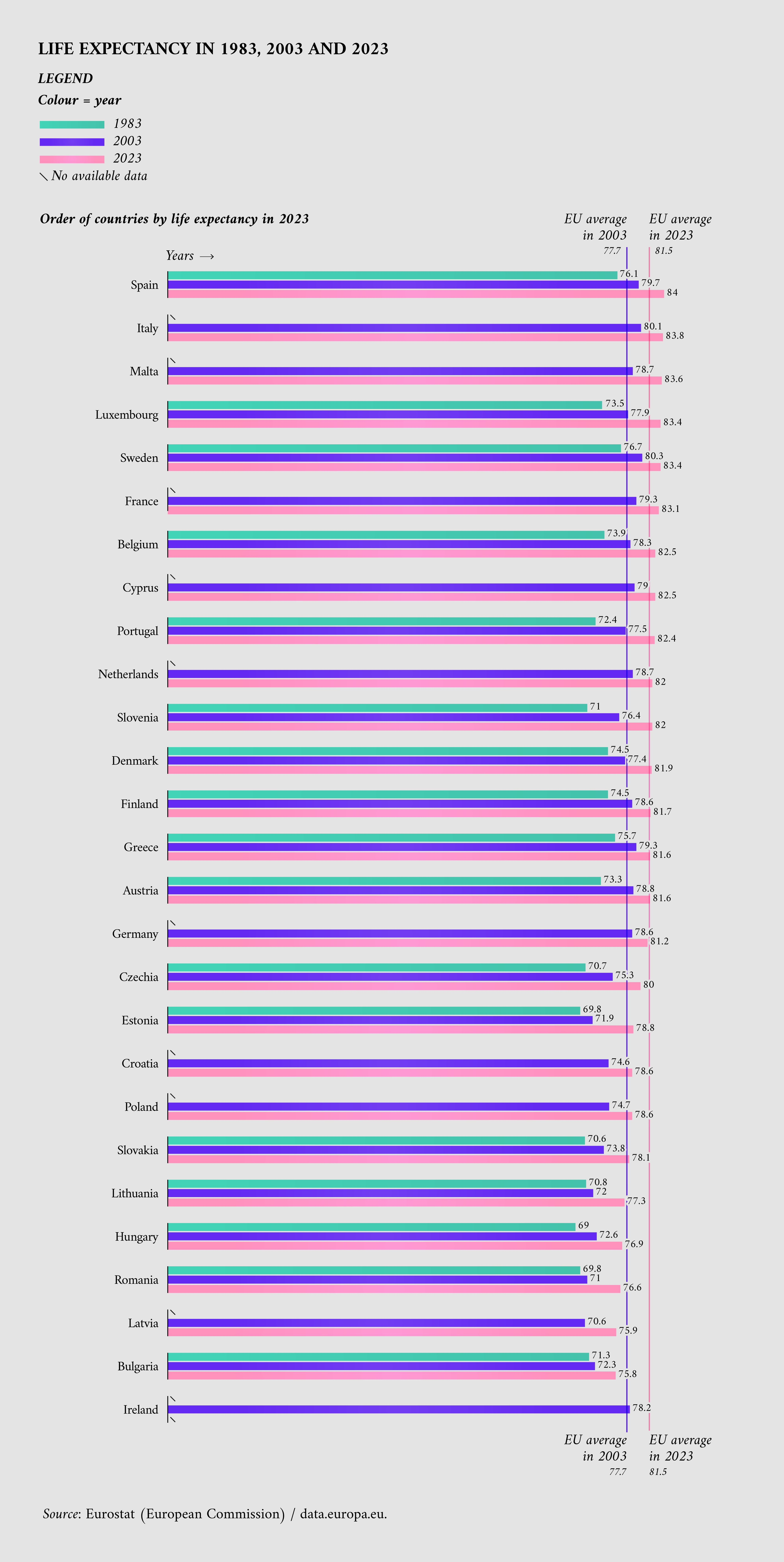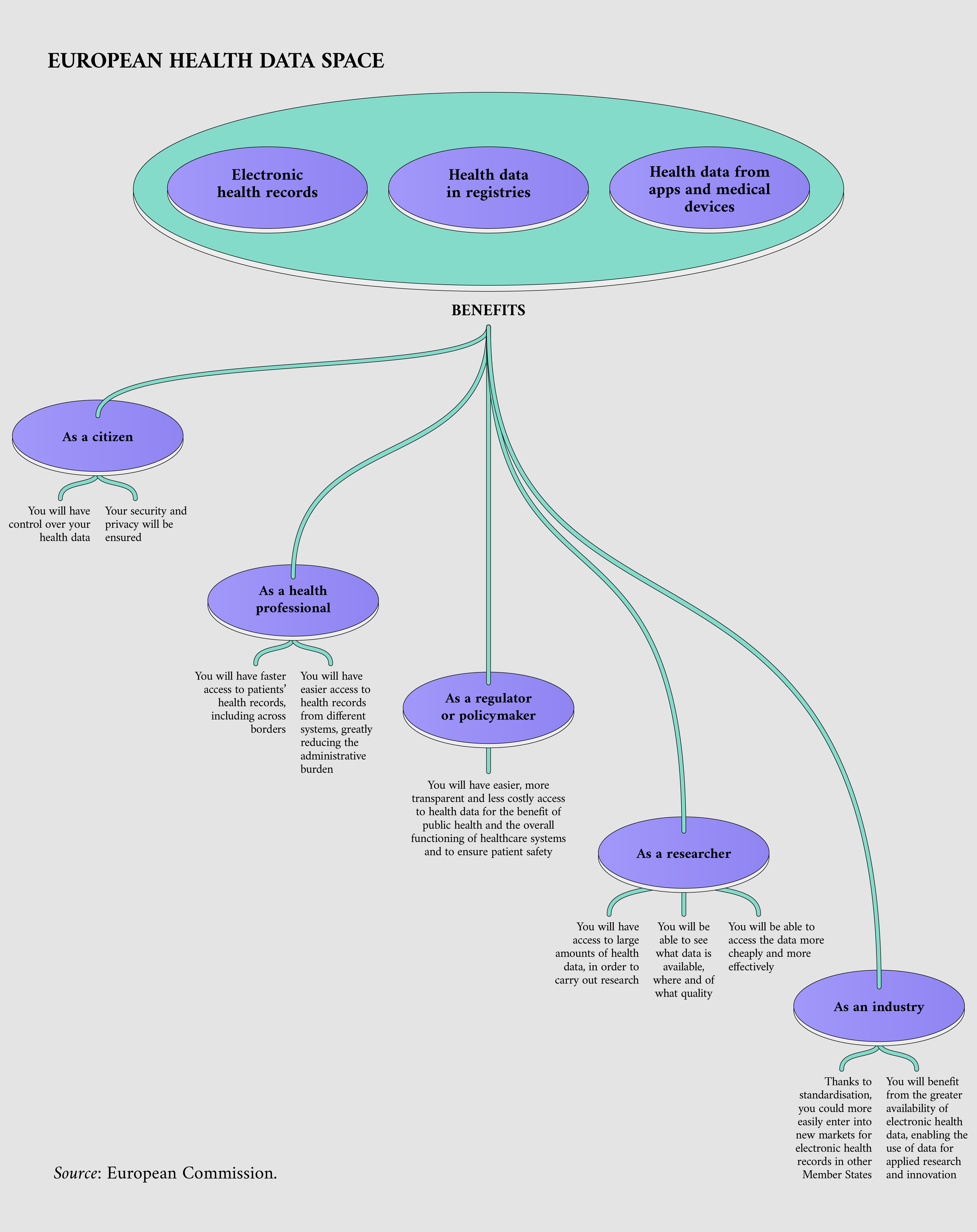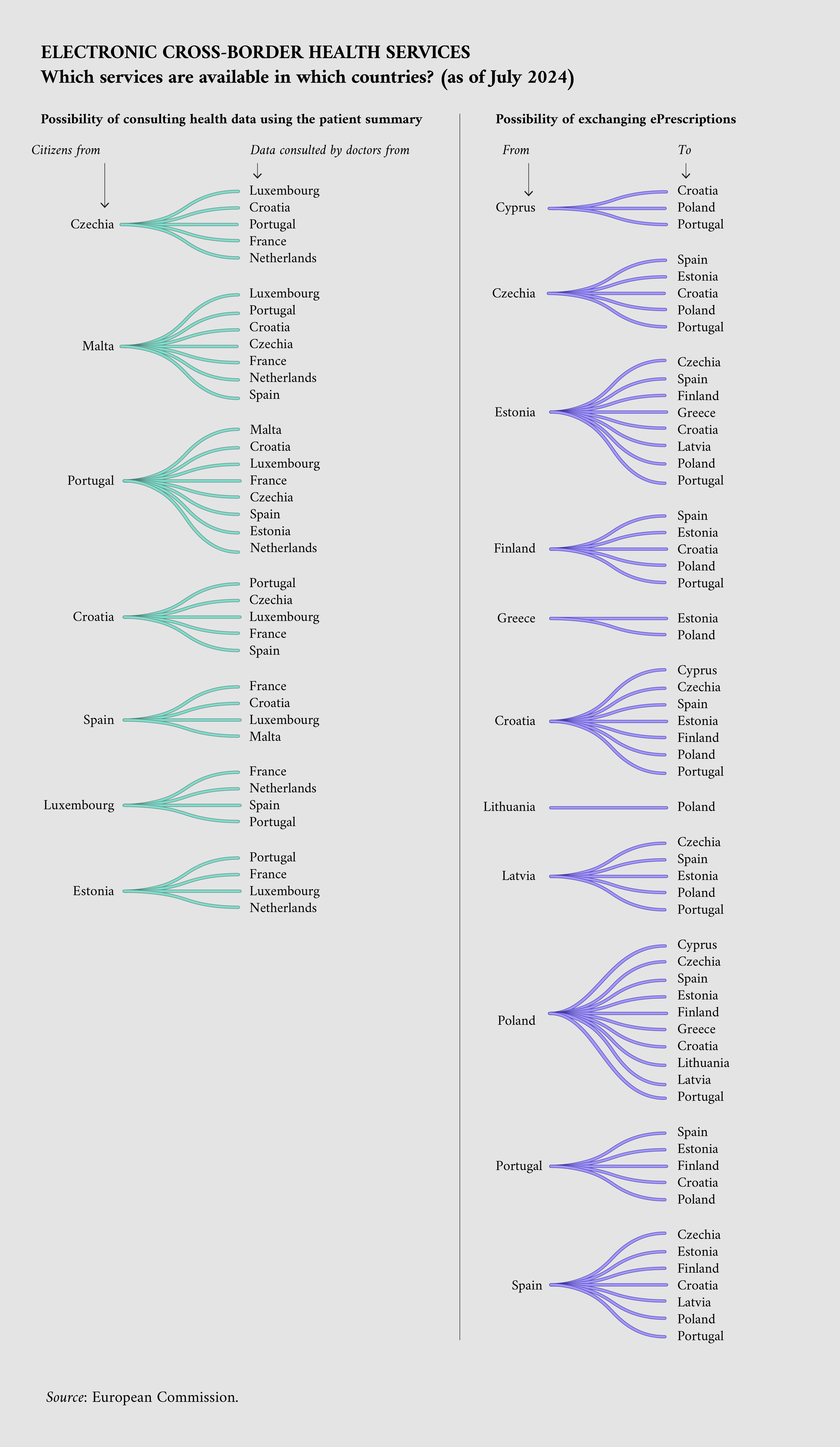Pioneering the EU’s sector-specific data spaces: The European Health Data Space
How interoperable open data and restricted health data can improve the delivery of health services across the EU
Data is transforming the way we produce, consume and live. It is a key driver of innovation for services and products. In our previous data story, ‘When open data meets data spaces’, we explored the concept of data spaces, particularly the establishment of common European data spaces in strategic fields such as health, agriculture, manufacturing, energy, mobility, finance and public administration.
Today, we are focusing on one of those data spaces, namely the European Health Data Space. This is one of the first common European Union (EU) data spaces to emerge from the European strategy for data, which aims to create a single market for data to enhance Europe’s global competitiveness and data sovereignty (the ability to govern and control one’s own data). On 24 April 2024, the European Parliament and the Council of the European Union reached a political agreement on the Commission’s proposal for the European Health Data Space. This landmark decision paves the way for a transformative approach to healthcare data management and utilisation within the EU. The European Health Data Space is a structured environment where health-related data, including both open data and restricted data, can be securely stored, accessed and shared among authorised stakeholders. Practically, this means that medical researchers can access and pool data from various sources to accelerate the discovery of groundbreaking treatments and that medical professionals across the EU can access a patient’s medical history (with the patient’s consent) to provide better treatments. It is crucial to note that access to personal health data is strictly controlled and only available to authorised entities, ensuring the privacy and security of individuals’ health information. The resulting improved cross-border health system offers numerous benefits to EU citizens, including better access to healthcare services, more efficient and effective medical treatments and a more responsive and resilient health system overall. In this data story, we illustrate the current state of health data and how the European Health Data Space works in practice. Specifically, we analyse the role of open data in this data space and two key pillars: the HealthData@EU pilot, the pilot version of the final European Health Data Space, and MyHealth@EU, an initiative powered by the eHealth Digital Service Infrastructure that ensures continuity of care for EU citizens while travelling.
Open data versus restricted data within the European Health Data Space
Open data plays a pivotal role in the European Health Data Space by reducing barriers to data sharing and promoting secure, transparent data usage. Only a part of the data within the European Health Data Space is open data, and this covers anonymised and aggregated data that can be freely used, modified and shared by anyone. This type of data helps create insights and drive research without creating any concerns about individual privacy. On the other hand, other types of health data within the European Health Data Space, such as personal health records or sensitive medical information, are subject to strict access controls and are only available to authorised users under specific conditions, further safeguarding privacy and security. The interaction between open data and restricted health data within the European Health Data Space is designed to maximise the benefits of data sharing while safeguarding privacy and security. For example, open health data can be used to inform public health initiatives or guide research, while restricted data can be securely accessed by researchers or healthcare providers to develop personalised treatments or conduct in-depth studies.
The EU’s open data on healthcare
Open data related to healthcare is already available and widely used. For instance, Eurostat maintains an extensive EU-wide database of open health data, which can also be accessed through data.europa.eu. This database provides access to numerous datasets on a wide range of health-related topics. For example, Figure 1 shows the average life expectancy across EU Member States in 1983, 2003 and 2023. We observe an increase in life expectancy across all Member States, with the overall EU average rising almost 5 %, from 77.7 years in 2003 to 81.5 years in 2023. The countries leading in life expectancy have changed over the years: Sweden had the highest average life expectancy in 1983 at 76.7 years; Italy took the lead in 2003 with 80.1 years; and Spain topped the list in 2023 with an average of 84 years. Notably, among Member States with available data for both 1983 and 2023, Slovenia, Portugal and Luxembourg, in this order, experienced the highest percentage growth in life expectancy over the decades, with increases ranging between 13.5 % and 15.5 %.
Open health data like this offers valuable insights into health conditions and patterns but also infrastructure and services, helping to identify areas needing improvement and guide effective interventions. While the open health data currently available is extensive, expanding its potential and consolidating it into a unified data space can significantly enhance its impact. This is the goal of the European Health Data Space.

Figure 1: Life expectancy across the EU in 1983, 2003 and 2023 (source: data.europa.eu, Eurostat)
Increased sharing of health data through the HealthData@EU pilot
The European Health Data Space aims to revolutionise the health data economy. Its main objectives include:
- empowering individuals to take control of their health data by ensuring they have access to and can manage their own health information;
- facilitating the exchange of data for healthcare delivery across the EU (primary use of data).
It also seeks to foster a unified framework for electronic health record systems and provide a consistent, trustworthy and efficient system for reusing health data for research, innovation, policymaking and regulatory activities (secondary use of data). This initiative is expected to stimulate significant growth in the health data economy, fostering innovation and collaboration across the EU. Figure 2 illustrates how the health data space integrates various sources of health data to create a comprehensive repository, enhancing health benefits for patients, researchers, innovators and regulators. For example, policymakers and researchers will benefit from more efficient access to comprehensive health data, which will result in better data-based regulations and more advanced evidence-based research and innovation. This is expected to result in EUR 5.5 billion of savings in the EU over 10 years due to the improved access and exchange of health data in healthcare. Additionally, the broader digital health market, which includes services and products such as telemedicine, health apps, wearable devices and digital health records, is anticipated to grow by 20–30 % as a result. Furthermore, better use of health data for research, innovation and policymaking is projected to save the EU EUR 5.4 billion over 10 years. Currently, the HealthData@EU Pilot has been launched with 17 partners, including health data access bodies, sharing infrastructures and EU agencies. This 2-year European project aims to build a pilot version of the European Health Data Space infrastructure. It serves as a foundational step towards the full implementation of the European Health Data Space, demonstrating the feasibility and benefits of an integrated health data space. It will provide valuable insights and feedback that will shape the future development and scaling of the European Health Data Space. You can explore its functioning here.

Figure 2: Overview of the functioning of the European Health Data Space and its related benefits (source: European Commission)
Cross-border health services: integrating health data across the EU
As part of the healthcare data strategy, new electronic cross-border health services aim to be implemented progressively in the EU by 2025. The eHealth Digital Service Infrastructure ensures continuity of care for EU citizens travelling within the European Union by enabling countries to securely, efficiently and interoperably exchange health data. Under the European Health Data Space, the EU has launched the initiative MyHealth@EU, which offers two essential electronic cross-border health services across Member States.
- ePrescription and eDispensation. This service allows EU citizens to obtain medication from pharmacies in any Member State. This not only enhances convenience but also ensures that individuals receive consistent and appropriate medical treatment regardless of their location within the EU.
- Patient summaries. These summaries enable doctors to access vital patient information in their own language, overcoming potential language barriers when treating patients from other Member States.
These services enable, for instance, Spanish healthcare providers to access the medical history of a Portuguese citizen who is travelling in Spain and requires medical attention. Similarly, they enable a Croatian patient to visit a pharmacy in Finland and have their prescription filled using an electronic prescription issued in Croatia.
Figure 3 illustrates the availability of ePrescription and patient summaries across Member States as of July 2024.
These services are critical because they enhance healthcare accessibility and continuity for EU citizens, ensuring that medication and critical health information is available regardless of geographical location. This cross-border health data exchange fosters improved patient care, safety and convenience, ultimately contributing to a more integrated and efficient European healthcare system. It reduces the risk of complications, missing information and redundant tests. You can further explore the services available in your country in this interactive dashboard.

Figure 3: EU cross-border health services as of July 2024 (source: European Commission)
Conclusion
A sector-specific health data space facilitates secure and interoperable health data exchange. Resulting applications such as HealthData@EU and MyHealth@EU are key elements within this health data space, ensuring that EU citizens can rely on consistent and high-quality healthcare, whether at home or abroad. This integrated approach not only improves individual health outcomes but also strengthens the overall resilience and responsiveness of the European healthcare system, paving the way for future advancements in health data management and utilisation.
Within the European Health Data Space, open data offers opportunities for public use and research without restrictions, while other data is subject to access controls to protect privacy and ensure that data is used responsibly. By combining these different types of data, the European Health Data Space aims to create a comprehensive and secure environment that maximises the benefits of health data for all stakeholders.
Do you want to explore existing health-related issues through open data? You can access numerous open datasets on data.europa.eu. Stay up to date on our upcoming data stories and webinars by subscribing to our newsletter and following data.europa.eu on social media.
